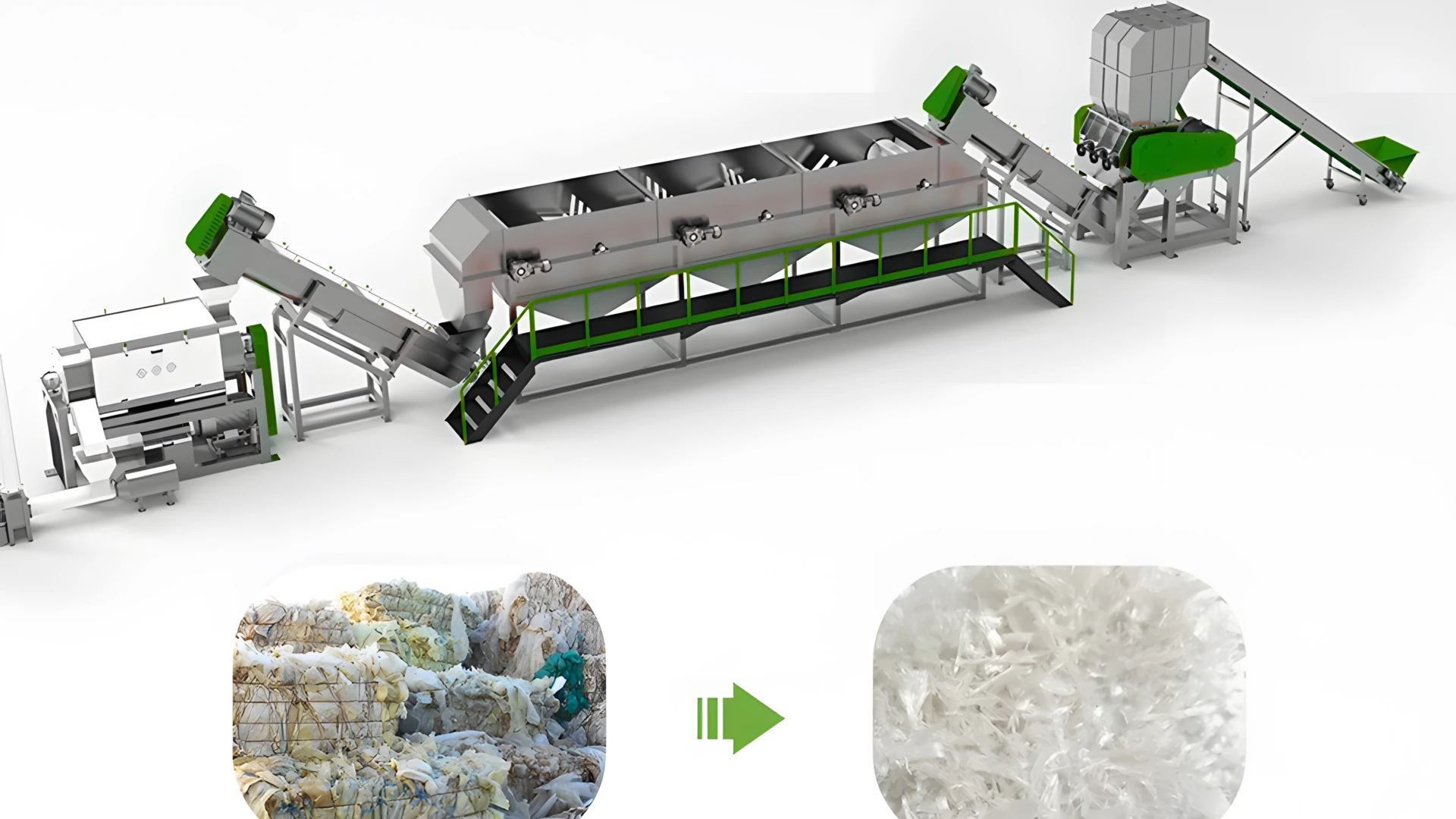Baloturile de folie de plastic uzată — cum ar fi folia agricolă LDPE sau pungile țesute din PP post-consum — au o valoare semnificativă, dar numai dacă pot fi transformate într-o materie primă curată și pură. Aici se află... Linie de spălare cu folie de plastic devine esențial. Este un sistem sofisticat de mașini care lucrează împreună pentru a mărunți, freca, separa și usca plasticul murdar, pregătindu-l pentru noua sa viață sub formă de pelete.
O linie de spălare bine proiectată este inima oricărei operațiuni de reciclare a foliei cu succes. Este pasul critic care transformă deșeurile contaminate în fulgi de plastic de înaltă calitate, comercializabili, gata pentru peletizare și fabricare.
O linie de spălat standard se învârte de obicei în jurul a patru procese de bază:
- Reducerea dimensiunii: Tocător și/sau Concasor (Granulator)
- Spălare și frecare: Șaibă cu frecare de mare viteză
- Separare și purificare: Rezervor de separare chiuvetă-plutitor
- Uscare: Mașină de deshidratare și/sau uscător cu presă cu șurub
Haideți să analizăm fiecare etapă pentru a înțelege cum funcționează împreună pentru a obține rezultate impecabile.
Pasul 1: Reducerea dimensiunii — Prima tăiere critică
Înainte de a putea spăla folia, trebuie să o descompui în bucăți mai mici, ușor de manevrat. Acest pas inițial este crucial din mai multe motive:
- Previne blocajele: Împiedică încurcarea pungilor întregi de plastic în jurul rotoarelor și arborilor, ceea ce ar paraliza producția și ar reprezenta un risc pentru siguranță.
- Crește suprafața: Piesele mai mici au o suprafață expusă mai mare pentru o curățare mai eficientă și mai temeinică.
- Asigură transportul fără probleme: Fragmentele de dimensiuni uniforme circulă ușor între diferitele mașini de pe linie.
Pentru această sarcină, aveți două opțiuni principale: un tocător industrial sau un concasor umed (granulator).
Opțiunea A: Tocătorul de documente de mare putere
Un tocător este o bestie cu viteză redusă și cuplu mare. Lamele sale puternice, montate pe arbori cu rotație lentă, pot rupe baloți întregi de folie comprimată, descompunându-i în bucăți de mărimea palmei sau mai mari (de obicei, de 2,5-12,7 cm). Deoarece funcționează la viteze reduse, generează un nivel minim de zgomot și praf.
Avantaj cheie: Capacitatea unui tocător de a procesa baloți întregi de folie, nedespărțiți este principalul său argument de vânzare. Pentru centrele de reciclare cu volum mare de deșeuri care doresc să maximizeze automatizarea și să reducă munca manuală, un tocător este indispensabil.
Opțiunea B: Concasorul de mare viteză (granulator)
În schimb, un concasor (sau granulator) funcționează la viteze mult mai mari (200-800 RPM). Pe măsură ce cuțitele rotorului se rotesc pe lângă cuțitele fixe din interiorul unei camere de tăiere, acestea forfecează plasticul în fulgi mai mici și mai uniformi. Materialul poate ieși doar după ce este suficient de mic pentru a trece printr-o sită din partea de jos.
Pentru frânghiile de rufe, a granulator umed este foarte recomandat. Pulverizează continuu apă în camera de tăiere, atingând două obiective simultan: reduce dimensiunea materialului și efectuează o pre-spălare inițială a peliculei murdare. Apa lubrifiază și lamele, reducând căldura și uzura.
Tocător vs. Concasor: Care este potrivit pentru tine?
Cea mai bună alegere depinde de materia primă și de obiectivele operaționale. Multe linii de înaltă performanță folosesc ambele: un tocător pentru descompunerea primară a baloților, urmat de un concasor umed pentru măcinare mai fină și pre-spălare.
| Caracteristică | Tocător | Concasor (Granulator) |
|---|---|---|
| Material de intrare | Baloturi întregi de folie | Folie liberă (baloții trebuie rupți mai întâi) |
| Operațiune | Turație redusă, cuplu mare | Viteză mare, cuplu redus |
| Dimensiune de ieșire | Bucăți mai mari, mai puțin uniforme | Fulgi mai mici și mai uniformi |
| Zgomot și praf | Zgomot și praf minime | Zgomot și praf mai ridicate (atenuate de carcase) |
| Toleranță la contaminanți | Excelent. Rezistă bine la murdărie, nisip și unele obiecte dure. | Sărac. Ușor de deteriorat de contaminanți duri, cum ar fi pietrele sau metalul. |
| Întreţinere | Mai complexe, schimbările lamelor necesită mult timp. | Mai simplu, lamele sunt mai ușor și mai rapid de schimbat. |
| Cel mai bun pentru… | Linii automate cu volum mare de lucru sau procesarea peliculelor puternic contaminate. | Linii de volum mai mic sau ca mașină de măcinat secundară pentru un randament uniform. |
Pasul 2: Spălare și frecare de mare intensitate
Șaibă cu frecare de mare viteză
După reducerea inițială a dimensiunii, începe curățarea propriu-zisă. O mașină de spălat cu frecare de mare viteză este concepută pentru a freca energic fulgii de plastic. Nucleul său este un ax lung, înclinat, cu palete care se rotesc la peste 1.000 RPM.
Pe măsură ce materialul intră în capătul inferior, paletele de mare viteză creează o frecare intensă între fulgii de plastic, îndepărtând murdăria persistentă, praful și etichetele de hârtie. Apa este pulverizată continuu în interior și forța centrifugă aruncă apa murdară și contaminanții printr-o sită înconjurătoare. Materialul curat este împins în sus prin camera înclinată și evacuat pe partea superioară.
Această mașină este deosebit de eficientă la îndepărtarea contaminării cu hârtie și carton, care se descompune în celuloză și se elimină ușor.
Pasul 3: Separare și purificare
Rezervor de separare chiuvetă-plutitor
Rezervorul cu chiuvetă și plutitor este un maestru al separării, îndeplinind două funcții:
- Curățare suplimentară: Permite fulgilor de plastic să se îmbibe, desprinzând orice murdărie rămasă.
- Separarea densității: Separă plasticul dorit de contaminanții mai grei.
Principiul este simplu: folia de plastic (precum PE și PP) este mai puțin densă decât apa (densitatea < 1,0 g/cm³), deci plutitoareContaminanți mai grei, cum ar fi nisipul, rocile, sticla și metalul scufunda până la fund.
Tamburi cu palete care se rotesc lent îndepărtează fulgii de plastic curați și plutitori de la suprafața apei și îi mută în etapa următoare. Contaminanții care se acumulează pe fundul conic al rezervorului sunt îndepărtați periodic de un transportor cu șnec sau o supapă pneumatică.
Alternativă: Separator ciclonic
Deși mai frecvent în Reciclarea sticlelor PETSeparatoarele cu hidrociclon pot fi utilizate și pentru peliculă. Acestea utilizează un flux de apă de înaltă presiune pentru a crea un vortex centrifugal care separă materialele după densitate cu o eficiență chiar mai mare decât un rezervor standard cu plutitor.
Pasul 4: Uscarea și deshidratarea
Etapa finală, crucială, de uscare
Uscarea este ultima și una dintre cele mai importante etape. Pentru a evita probleme precum bulele de aer și imperfecțiunile în timpul peletizării prin extrudare, conținutul de umiditate al fulgilor de film finali trebuie redus semnificativ, în mod ideal până la sub 15%Există două metode principale pentru a realiza acest lucru.
Metoda 1: Deshidratare centrifugă + Uscare cu aer cald
Acest proces în două etape este extrem de eficient.
- Mașină de deshidratare: Fulgii umezi intră mai întâi într-o mașină centrifugă de deshidratare (similară din punct de vedere structural cu o mașină de spălat cu frecare). Aceasta se învârte la viteze mari, folosind forța centrifugă pentru a îndepărta cea mai mare parte a apei de pe fulgi, reducând de obicei umiditatea la intervalul 20-30%.
- Uscare cu aer cald: Fulgii deshidratați sunt apoi transportați printr-o serie de tuburi unde sunt amestecați cu aer cald. Acesta evaporă umiditatea rămasă înainte ca fulgii să fie colectați într-un separator ciclonic.
Metoda 2: Uscător cu presă cu șurub
O presă cu șurub oferă o soluție de uscare mai economică, într-o singură etapă. Folosește o presiune fizică imensă pentru a stoarce literalmente apa din fulgii de plastic.
Nucleul mașinii este un șnec mare, conic. Pe măsură ce materialul umed este introdus, spațiul micșorat din interiorul șnecului comprimă plasticul, forțând apa să iasă prin găuri mici dintr-o sită înconjurătoare. Această comprimare mecanică poate reduce eficient conținutul de umiditate la nivelul țintă, fără costurile energetice ale uscătoarelor cu aer cald.
Cum să personalizezi firul perfect de spălare a foliei
Nu există o soluție universală. Configurația ideală a sforii de rufe depinde în întregime de doi factori:
- Tipul de folie de plastic pe care o procesați.
- Nivelul și tipul de contaminare.
De exemplu, o linie de bază pentru o curățenie relativ curată Folie LDPE 98/2 ar putea consta dintr-un concasor umed, un rezervor cu plutitor și un uscător cu presă cu șurub.
Totuși, dacă procesați folie agricolă foarte murdară, veți avea nevoie de un sistem mai robust. Ați putea adăuga un tocător înainte de concasor pentru a proteja lamele și a manipula materialul balotat. Probabil ați încorpora unul sau chiar două șaibe de frecare de mare viteză pentru a asigura o curățare profundă.
Concluzie: Partenerul tău în materie de plastic curat
O linie de spălare a foliei de plastic este un sistem dinamic în care fiecare componentă joacă un rol vital în procesul de transformare a deșeurilor în valoare. Înțelegerea funcției fiecărei mașini - de la tocătoare și mașini de spălat cu frecare la rezervoare de separare și uscătoare - este primul pas către construirea unei linii eficiente, eficace și profitabile. Deoarece performanța echipamentelor poate varia semnificativ, cea mai bună soluție este să consultați un expert pentru a configura un sistem perfect adaptat obiectivelor dumneavoastră specifice privind materiile prime și produsul finit.



